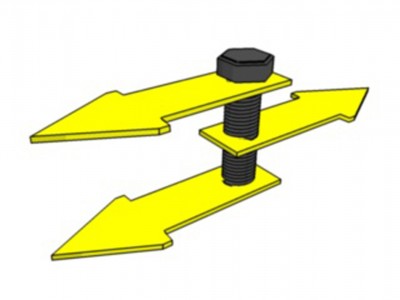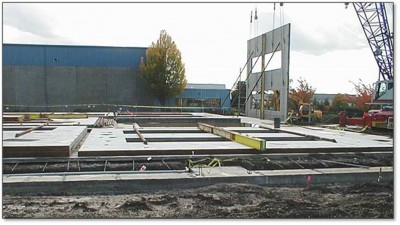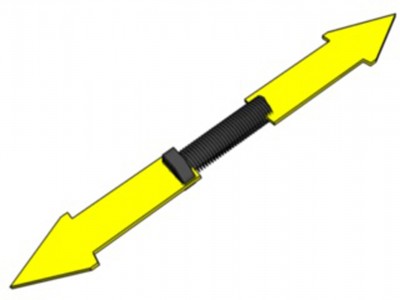
Tension force (left) affects signs suspended from the undersides of canopies, while shear force (right) will affect flush-type wall signs.
Bolt basics
Regardless of the type of structure a sign is attached to, the fasteners must withstand two basic types of force: shear and tension.
Bolts used to attach flush-type wall signs are mainly subject to shear force. A properly fastened wall sign becomes integral to the building wall itself; for this reason, tension or pullout force is not a significant factor. For suspended-type signs that are attached to the undersides of canopy structures, however, tension force represents an important factor.
Building codes may specify minimum sign-fastener sizes for certain applications. The use of engineered fasteners or alternative fastening methods may also be specified by the customer. So, it is always important to confirm in advance whether or not a particular method will be specified for a given project.
Further, the project specifications or jurisdictional regulations may also determine the type of fasteners that will be acceptable for use. The International Building Code (IBC), for example, specifies a minimum fastener size of 9.5 mm (0.37 in.) in diameter and 127 mm (5 in.) in length when attaching signs to exterior masonry, concrete or stone walls.
Engineered fasteners are rated by the manufacturer for specific load values, as verified by lab testing. Non-engineered fasteners (e.g. lag screws and toggle bolts) are not engineered and their load values are not specified. Instead, the load capacity of lag screws and other types of wood screws is variable, depending on the specific type, thickness and condition of the wood into which the fastener is inserted.

When using concrete screws, the installer needs to verify they are tightly secured into the wall material.
The ultimate load rating for a particular fastener or anchor is four times the fastener’s adjusted safe capacity. For example, a lag screw rated for 181.4 kg (400 lb) of ultimate capacity is suitable to support about 45.4 kg (100 lb). Ultimate capacity is also known as ‘proof test load.’
The mounting hardware furnished for wall sign installations generally incorporates bolt-hole sizes that dictate the use of fasteners that will be of adequate size to support the sign’s weight. Typical lag screw or machine bolt diameters for sign fastening applications range from 9.5 to 15.9 mm (0.37 to 0.63 in.).
Since wall signs and letters are typically fastened at multiple points, a sign’s total weight must be divided by the number of fasteners to determine the load rating for each fastener. For example, a 226.8-kg (500-lb) sign attached at six points would require each fastener to support approximately 37.6 kg (83 lb).
Using the right fasteners and installation techniques for a particular wall structure can keep a sign safe and secure for many years to come.
Bill Dundas is director of technical and regulatory affairs for the International Sign Association (ISA). This article is adapted from ISA Sign Academy online training resources. For more information, visit www.signs.org/online.







The sinks ought to be precisely found the focuses of the encircling individuals, to abstain from part through the sides of the timber when embedded and fixed.
Nice sharing!
I realized that welding is entirely restricted on the show bureau, including the mounting edges. Any extra entrances into the show bureau must be approved, in composing. Harm brought about from water spills as well as welding may void the guarantee. Exhibition Stand Design
Its easy to say we are a sign company and can design/print your signs, Custom signs fabrication and installation is something that nobody really offers in the industry. Signs NY is offering complete customer solutions in signs industry.